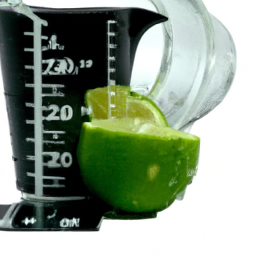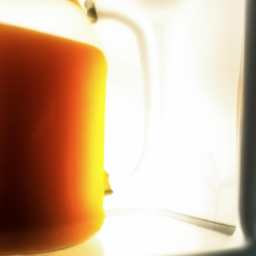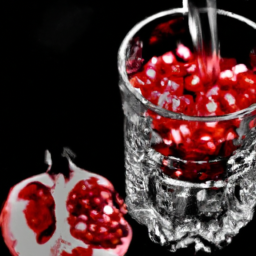As someone who enjoys both cooking and baking, I understand the importance of measuring the right amount of lemon juice for different recipes. Whether it’s adding a tangy flavor to a salad dressing or balancing the sweetness in a dessert, getting the precise amount of lemon juice is essential for the success of any dish.
However, determining how much juice is in half a lemon can be a bit tricky, especially if you’re not familiar with the factors that affect the yield of juice.
In this article, I will provide you with all the information you need to accurately measure the amount of lemon juice in half a lemon. From understanding the factors that affect juice yield to alternative ways to measure lemon juice, you’ll be equipped with the knowledge and tools necessary to ensure your recipes turn out perfectly every time.
So, let’s dive in and explore the world of lemon juice measurement!
Key Takeaways
- The accuracy of lemon juice measurement is important in recipes, as too much or too little can negatively impact both flavor and health.
- Lemon juice yield can be affected by the ripeness of the lemon and the juicing technique used.
- On average, a medium-sized lemon will yield 2-3 tablespoons of juice.
- Efficient ways to extract lemon juice include using a juicer, rolling the lemon before cutting, microwaving the lemon for 15 seconds, or using lemon squeezing gadgets or a fork/citrus reamer.
Importance of Knowing the Amount of Lemon Juice Needed
You gotta know how much lemon juice you need if you want your dish to have the perfect balance of tangy and sweet. Recipes requiring precision, such as baking recipes, call for specific amounts of lemon juice. If you use too much or too little, it can negatively affect the final product.
On the other hand, if you substitute lemon juice with other ingredients, you may not get the same flavor profile that the recipe intended. Knowing the amount of lemon juice needed is also important if you are trying to watch your calorie intake. Lemon juice is a low-calorie way to add flavor to dishes, but using too much can add up quickly.
Additionally, knowing how much juice is in half a lemon can help you plan out how many lemons you need to buy for a recipe. Factors that affect the amount of juice in a lemon include the size of the lemon, its ripeness, and how it is juiced.
Factors that Affect the Amount of Juice in a Lemon
When squeezing a lemon, the amount of liquid you get depends on various factors, such as the fruit’s ripeness, its size, and the amount of pressure applied.
Lemon ripeness is an important factor because ripe lemons tend to produce more juice than unripe ones. Ripe lemons are softer and juicier, making them easier to squeeze. On the other hand, unripe lemons are harder and contain less juice, which means you may need to use more of them to get the desired amount of lemon juice.
Another factor that affects the amount of juice in a lemon is juicing technique. When squeezing a lemon, it’s important to apply the right amount of pressure and to use a juicer or your hands in the correct way. Applying too much pressure can cause the lemon to release bitter oils, which can affect the taste of the juice. On the other hand, not applying enough pressure can result in a lower yield of juice. By using the right technique, you can maximize the amount of juice you get from a lemon.
With these factors in mind, let’s move on to the next section about average yield of lemon juice.
Average Yield of Lemon Juice
The satisfaction of a zesty lemon flavor in your dishes can be enhanced by knowing the average amount of lemon juice you can get from a single fruit. On average, a single medium-sized lemon can yield around 2-3 tablespoons of juice. This amount may vary depending on factors such as the ripeness of the fruit, its size, and the juicing method used.
Knowing the average yield of lemon juice is important for those who love to cook with this versatile citrus fruit. Recipes using lemon juice can range from simple salad dressings and marinades to more complex desserts and baked goods. Additionally, lemon juice has several nutritional benefits such as being a great source of vitamin C, aiding in digestion, and promoting healthy skin.
With the knowledge of how much juice to expect from a single lemon, you can confidently add this ingredient to your dishes and reap its many benefits. Moving on to the next section, it’s important to note that calculating the amount of juice in half a lemon is just as crucial for achieving the perfect balance of flavors in your cooking.
Calculation for Half a Lemon
If you’re worried about not having enough lemon flavor in your dish, don’t fret – there’s a simple calculation you can use to ensure you’re using the perfect amount of citrus. Converting measurements can be tricky, but when it comes to lemon juice, it’s easy to determine how much juice is in half a lemon.
Here’s how:
- Cut a lemon in half
- Squeeze the juice out of both halves into a measuring cup
- Record the amount of juice
- Divide that amount in half
- Use that resulting number as the measurement for half a lemon
It’s important to note that the citric acid content in lemons can vary, so the amount of juice you get from a half of a lemon may differ slightly from one lemon to the next. However, using this calculation will give you a good estimate and help ensure you’re using the right amount of lemon juice in your recipe.
Incorporating the right amount of lemon juice is crucial to achieving the desired flavor in your dish. That’s why accuracy in measuring is so important.
In the next section, we’ll explore the various methods of measuring lemon juice and how to ensure you’re getting the most accurate measurement.
Importance of Accuracy in Measuring
Accurate measuring is crucial to achieving the perfect balance of tangy citrus flavor in your dish, ensuring a harmonious blend of ingredients. Measuring techniques play a significant role in determining the amount of juice extracted from a lemon. Some common methods include cutting the lemon in half and squeezing it by hand or using a juicer. However, it is important to note that the amount of juice extracted may vary depending on factors such as the ripeness and size of the lemon.
To ensure accuracy when measuring lemon juice, it is crucial to avoid common mistakes such as not using the right measuring tools or not measuring the juice precisely. Using a small measuring cup or spoon can help to ensure that the amount of juice used is accurate. Additionally, it is essential to measure the juice after it has been extracted from the lemon to avoid any loss or gain of juice during the extraction process. By following these simple measuring techniques and avoiding common mistakes, you can achieve the perfect balance of citrus flavor in your dish.
With too much lemon juice, the dish can become overly sour and unappetizing. Therefore, it is important to measure the juice accurately to avoid any negative impact on the overall taste of the dish.
Impact of Too Much Lemon Juice
You don’t want to ruin your dish by going overboard with the tangy citrus flavor. While lemon juice can add a zing to your culinary creations, too much of it can overpower other flavors and make your dish unappetizing.
Additionally, consuming excessive amounts of lemon juice can pose potential health risks, such as tooth decay and digestive issues. However, this doesn’t mean that lemon juice should be avoided altogether.
In fact, it has a wide range of culinary applications, from enhancing the flavor of savory dishes to adding a refreshing twist to sweet desserts. The key is to use it in moderation and balance it with other ingredients.
By doing so, you can enjoy the benefits of lemon juice without the negative consequences. Now, let’s explore the impact of too little lemon juice on your dish.
Impact of Too Little Lemon Juice
Don’t be afraid to add a little bit more tanginess to your dish with some extra lemon juice, as too little can result in a lack of brightness and depth in flavor. Lemon juice is a key ingredient that enhances the taste of many dishes, and without it, your recipe may fall flat. If you don’t add enough lemon juice, your dish may taste dull and lack the zesty, bright flavor that it needs. This lack of flavor can ruin the overall taste of your recipe and leave you feeling unsatisfied.
To ensure that you’re using the right amount of lemon juice in your recipe, it’s important to measure it accurately. One way to do this is by using a measuring spoon or cup. Another option is to use a juicer that extracts the juice and separates it from the seeds and pulp. Regardless of the method you choose, it’s important to keep in mind that too little lemon juice can have a negative impact on your dish. So, don’t be afraid to add a little extra tanginess to your recipe to give it the flavor it deserves.
Now, let’s dive into alternative ways to measure lemon juice and make sure that your recipe is perfectly balanced.
Alternative Ways to Measure Lemon Juice
An alternative method for measuring the tartness of your dish is by incorporating freshly squeezed lemon. While measuring the amount of juice from half a lemon can be tricky, there are different squeezing techniques that can help you get the most out of your lemon.
One way is to use a juicer. This tool can extract every drop of juice from your lemon without wasting any precious juice. Simply cut your lemon in half and place it in the juicer, then use the handle to squeeze out the juice. This method isn’t just efficient but also helps you avoid getting any seeds in your dish.
Another way to measure lemon juice is by using your hands. Cut your lemon in half and squeeze it with your hands over a bowl or strainer. Roll the lemon before cutting to loosen the juice and make it easier to extract. To get the most juice out, make sure to apply pressure evenly throughout the lemon. This method may not be as precise as using a juicer, but it’s a quick and easy way to add a burst of lemon flavor to your dish.
Now, let’s move on to some tips for getting the most juice out of a lemon.
Tips for Getting the Most Juice Out of a Lemon
To maximize your lemon’s potential, try microwaving it for 15 seconds before juicing. This can help the lemon release up to 30% more juice!
When it comes to juicing techniques, there are a few things you can do to get the most juice out of your lemons. One tip is to roll the lemon on a hard surface before cutting it open. This helps to break down the cells inside the lemon, making it easier to extract the juice.
Another helpful tip is to use a lemon squeezing gadget. There are many different types available, from handheld squeezers to electric juicers. These gadgets can save you time and effort, as well as provide a consistent amount of juice.
However, if you don’t have a gadget, you can still get great results by using a fork or a citrus reamer to manually extract the juice from the lemon.
With these tips and tricks, you’ll be able to get the most juice out of your lemons and add that extra zing to your recipes!
Frequently Asked Questions
Can you use bottled lemon juice instead of fresh lemon juice?
I’ve found that using bottled lemon juice can be convenient, but there are drawbacks. It lacks the fresh taste and may contain preservatives. In a taste test comparison, fresh lemon juice always wins.
How long does a lemon stay fresh after being cut in half?
I know you might be hesitant to use leftover lemon halves, but with the right storage method, they can stay fresh for up to a week. Some great recipes to use them in include salad dressings, marinades, and cocktails.
Is it necessary to remove the seeds from a lemon before juicing it?
Removing lemon seeds is a necessary step for a quality, fresh lemon juice. The seeds can add a bitter taste and affect the texture. Freshly squeezed lemon juice is always better than bottled, as it contains more nutrients and flavor.
Can you use a blender or food processor to extract lemon juice?
Personally, I prefer hand juicing or using a lemon squeezer over a blender or food processor for extracting lemon juice. These methods yield more juice and less pulp. However, it ultimately depends on personal preference and the desired outcome.
Does the ripeness of a lemon affect the amount of juice it yields?
As a lemon enthusiast, I can attest that the ripeness of a lemon impacts its juice yield. Ripe lemons tend to have softer flesh, making it easier to extract more juice. This makes them ideal for juicing, especially when trying to maximize the amount of lemon juice yield.
Conclusion
So, there you have it – the answer to the question of how much juice is in half a lemon. It’s not an exact science, but knowing the average yield can help you get a pretty good estimate.
However, it’s important to remember that accuracy is key when it comes to measuring ingredients for a recipe. As the saying goes, ‘a little goes a long way’- and this is especially true when it comes to lemon juice. Adding too much can overpower a dish, while not adding enough can leave it lacking in flavor.
So, be sure to measure carefully and adjust as needed. With these tips and tricks in mind, you’ll be able to add just the right amount of lemon juice to your recipes and create delicious dishes that will leave your taste buds singing.
Ilana has been a vegan for over 10 years. She originally made the switch for health reasons, but soon found herself becoming more and more passionate about the ethical and environmental implications of a vegan lifestyle. Ilana is the author of The Graceful Kitchen, a blog all about veganism. She loves to cook up delicious and nutritious vegan meals, and share her recipes with others who are interested in leading a cruelty-free life. Ilana is also a strong advocate for using whole foods as the foundation of a healthy diet, and believes that going vegan is one of the best ways to achieve this.










